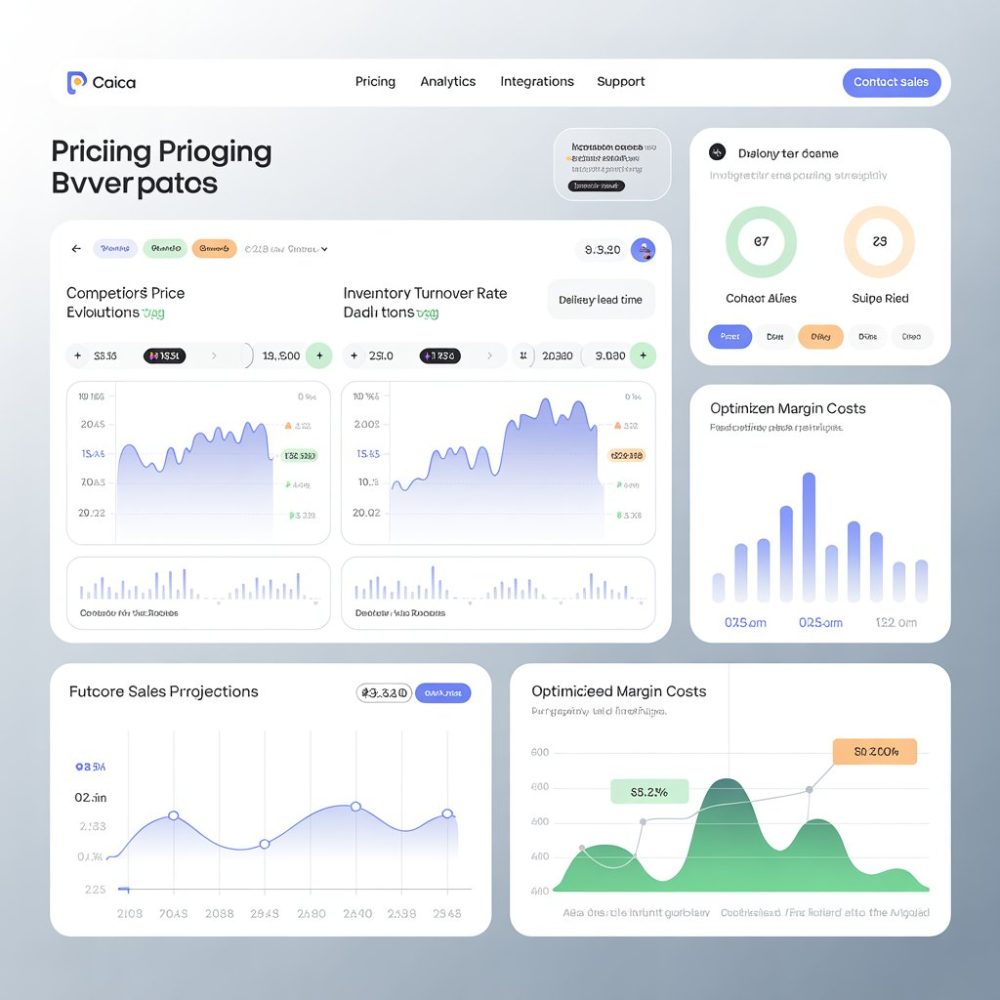A pricing strategy solution helps you regain control your pricing policy act with precision and consistency, and optimize your competitiveness and profitability over the long term.

Pricing: a pillar of your real-time performance
In an ultra-competitive environment where prices are constantly changing, pricing is no longer a simple tactical operation: it’s an essential strategic lever. Yet many companies still rely on intuition or unsuitable financial strategy software to set their prices, to the detriment of their margins.
Implement a pricing solution gives you the means to gain precision, react in real time to market trends and align your business objectives with sound pricing decisions,
data-driven.

How can a solid pricing strategy transform your bottom line?
Structure your pricing policy clearly, consistently and in line with your business objectives (volume, margin, price image, etc.).
Make decisions based on factual data, by simulating the impact of price changes and tracking actual vs. forecast variances.
Automate the application of business rules across the entire product portfolio, even in complex environments.
Strong brand image Your prices truly reflect the customer's perceived value, reinforcing your brand image and your ability to sell at fair value.
Reduce errors and biases. No more empirical adjustments: pricing decisions are based on concrete data.
Optimize margins to intelligently adjust pricing and maximize profitability on a product-by-product basis.
Your pricing decisions deserve better than hunches.
Our pricing strategy solution gives you a comprehensive tool for designing, testing, deploying and adjusting your prices intelligently and profitably.

By adopting an approach based on concrete insights, you improve customer satisfaction: fair, well-positioned prices reinforce the perception of value and facilitate the purchasing decision.
The result? Customers who understand what they’re paying for… and why.
By defining pricing tiers and taking into account your commercial constraints (SRP, promotions, psychological rules), you can guarantee logical, understandable and controlled pricing at all levels of the offer.
The rules engine is fully customizable, enabling you to adapt your pricing strategy to the specificities of your sector, your products and your segmentation (brand, channel, customer typology...).
The result: a strategy aligned with your real business challenges.
By integrating elasticity data into your pricing strategy engine, you move from a static approach to a dynamic, performance-oriented one. This data enables you to adjust your prices in line with actual market reactions, anticipate impacts on volumes and margins, and better segment your actions.
The solution allows you to compare several versions of pricing strategy, simulate their impact and analyze the differences between projected and actual results. You can steer your decisions with tangible data, and quickly adjust your choices according to observed performance.
Our customers are our first ambassadors

“Thanks to the optimix solution, we have not only reduced the number of errors, but also maximized our analysis capabilities, particularly for segmenting our competitors (BtoB, BtoC, etc.). Our business teams have managed to halve their alignment time, with increased productivity: over 12,000 linked products in just 3 minutes. The solution is complete and covers our needs 360 degrees. The tool is ergonomic and price management is simplified.”
My experience of using the Optimix solution and working with the teams has been very positive.
The software has significantly improved our pricing decisions, thanks to accurate information. We have benefited from a solid relationship with the Optimix teams, and the rapid deployment in 6 months has reinforced our confidence in this successful collaboration.
Optimix is a high-performance, feature-rich solution that has improved our daily lives. Implementation was very quick, smooth and efficient. Price management is now more efficient. We continue to develop the solution with functionalities adapted to our needs. It's essential for us to be able to keep pace with business requirements. I'm very satisfied with the collaboration, both during deployment and today.
All your pricing needs in a single tool
Collect in store competitor prices, carried out by our surveyors via a dedicated mobile application.
Linking of competing products (automatic based on EAN or compared using a proximity score).
Link and structure your product ranges to improve readability, strengthen your price image and facilitate decision-making.
Design, configuration, and implementation of your pricing strategy. Creation of price alignment rules.
An advanced Data-Driven approach with AI to optimize your prices and inventory, by analyzing data in real time.
Visualize your pricing KPIs: price positioning, margins, elasticity, competitive gaps and strategy performance.
Business expertise integrated into the heart of the solution, and a flexible, customizable and actionable rules engine.
Want to optimize your pricing strategy? Contact us !
FAQ
XPA helps you :
A controlled pricing strategy enables you to influence profitability, competitiveness and customer loyalty. It helps you better manage margins, respond to market variations and steer your competitive positioning.
Thanks to our customizable pricing rules, you define your prices according to your costs, target margins, price elasticity, sales volumes and market trends. AI automatically adjusts prices in line with your objectives. You get new price proposals.
Yes, our module allows you to apply pricing rules in batches according to defined parameters. You can also manually adjust prices by product or store to maintain local control.
Yes, customized dashboards let you monitor your KPIs in real time : margin, sales volume, profitability, price sensitivity, etc.
Because it lets you regain total control over your pricing thanks to a modular suite, powerful, intuitive and 100% retail-oriented. With XPA, you combine AI precision flexibility of customized rules and visualization of your key indicators to make pricing decisions faster, fairer and more profitable.
In figures :
Compatible with your internal tools scalable, and designed to handle the complexity of integrated, franchised or hybrid networks, XPA is much more than a software: it’s a strategic performance lever.
Yes, the module integrates easily with your in-house tools (ERP, PIM, BI, etc.) via connectors or APIs. It guarantees seamless data synchronization and optimal use in your business processes.
Our algorithmic models such as best fit exploit historical data, market trends and your costs. This enables automatic recommendations to optimize prices, maximize revenues and ensure strategic consistency.
Accueil / Pricing Solution – Optimize your pricing strategy / Solution Price strategy